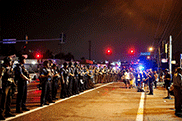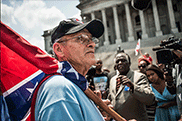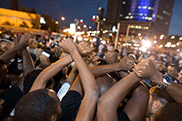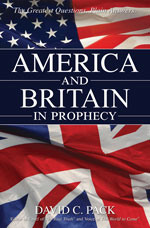 Kena Betancur/AFP/Getty Images
Kena Betancur/AFP/Getty Images
Article
Racial prejudice has led to unfathomable suffering—and a massive death toll. Is an end in sight?
Learn the why behind the headlines.
Subscribe to the Real Truth for FREE news and analysis.
Subscribe NowFerguson, Missouri, seemed to be in relative order. Then the mayhem started. Several vigils had just taken place marking the one-year anniversary of the death of an 18-year-old black man shot during an arrest by a white police officer. The incident ignited weeks of riots, looting and torching cars along with other property.
As nightfall set in, rowdy protesters who had been participating in demonstrations of civil disobedience began to throw rocks and bottles at police. A shooting nearby added to the confusion.
“Police and protesters faced off in a tense standoff on West Florissant Avenue, not far from Canfield Drive, where [the 18-year-old] was shot,” CNN reported.
“Several objects were thrown at police and some businesses damaged, the St. Louis County Police Department said. A journalist was attacked and robbed in a parking lot. Three St. Louis County police officers were injured: One was struck in the face by a brick, while two others were pepper-sprayed.
“Police, with helmets and shields, pushed crowds back and called in tactical units.
“‘We’re ready for what? We’re ready for war,’ some in the crowd chanted.”
The renewed unrest, which occurred for a three-day period, represented longstanding sentiments of frustration by black citizens toward the city’s primarily white police force, whom they believe have engaged in decades of racial profiling and segregation.
The Washington Post outlined some of the area’s history: “Ferguson, one of the 91 municipalities in largely white St. Louis County, has seen its population shift in recent years. About two-thirds of the city’s 21,100 residents are black. That’s a significant increase from 2000, when blacks made up just over half of the population. White residents, who had accounted for 44 percent of the population, now make up just under 30 percent.
“Yet the police force patrolling Ferguson has not changed along with the population. The police force has 53 members, and three of them are black. The city’s mayor and police chief are white, as are most of the members of the Ferguson City Council.”
Ferguson is not alone. Clashes as a result of racial tensions have occurred elsewhere across the country.
In April, a 25-year-old black man from Baltimore who was arrested for carrying an illegal switchblade subsequently sustained a fatal spinal cord injury while in a police transport vehicle.
After his funeral, “Armored vehicles lined this battered city’s main thoroughfares and thousands of law enforcement officers and National Guard troops worked to maintain order and enforce a citywide curfew,” The New York Times reported. “The authorities said that 15 buildings and 144 cars had been set on fire during [the] chaos, which began in Northwest Baltimore’s Mondawmin neighborhood and spread to other pockets of the city after morning funeral services for [the man], who was eulogized with soaring gospel music and impassioned calls for justice and peace. The police made 235 arrests. Nineteen police officers were injured…”
 Michael B. Thomas/AFP/Getty Images
Michael B. Thomas/AFP/Getty ImagesThen in June, a white man who associated himself with white supremacy ideology opened fire in a church in Charleston, South Carolina, and killed eight African American parishioners and the pastor. Yet again the nation was forced to deal with troubling racial tensions.
Yet racism is not just a problem in America—it occurs across the ocean as well in different forms.
PBS reported, “Between January and July 2014, according to data gathered by Jewish groups and the French government, the number of anti-Semitic acts in France nearly doubled compared to the same period in 2013. The same figures show half of all racist attacks in France target Jews, even though they number less than one percent of the population.”
In addition, Italy continues to grapple with racial tensions as more migrants, primarily from northern Africa, appear on its shores to live side-by-side with Italians.
“Violent clashes in Rome and the northern city of Treviso [in July] forced the police to evacuate migrants from local reception centers, after residents protested the ‘invasion’ of foreigners from the Middle East and Africa,” The New York Times reported. “Leaders of the Northern League, an anti-immigration party…pressured local mayors to refuse orders from Rome to settle migrants in their communities.”
Victims and perpetrators of racial prejudice are not confined to any certain period in history, or specific place, skin color, income group, or other category. No one is immune! What is unique is that the images we associate with the term racism depend largely on the part of the world in which we live.
For instance, those currently living in the United States most commonly think of tension between whites and blacks, or increasingly, Hispanics and blacks or whites. Further back, though, other forms existed.
It seems that wherever two distinct groups have contact, prejudice rears its ugly head.
In North America
Relations between American Indians and early New World colonists were often violent, with each side deeply distrustful of the other. One of the complaints against the British Crown recorded in the Declaration of Independence was that King George III “excited domestic insurrections amongst us, and has endeavoured to bring on the inhabitants of our frontiers, the merciless Indian Savages, whose known rule of warfare, is an undistinguished destruction of all ages, sexes and conditions.”
Yet groups discriminated against are not always those with skin darker than the majority. The fair-skinned Irish were once the object of prejudice in Great Britain and then in the United States. “The comic Irishman—happy, lazy, stupid, with a gift for music and dance—was a stock character of the English and American stage” (The Boston Globe).
Ethnic tensions boiled over in Pennsylvania in a largely Irish Catholic neighborhood in North Philadelphia in 1844 during a rally of the American Republican Party, which espoused anti-immigrant ideas.
According to an account from the Historical Society of Pennsylvania, a second rally took place several months later. “This time, three thousand nativists and Irishmen attended the meeting. As tensions began to mount between these two groups, a thunderstorm sent the crowd running for cover to the market house, and this is when the violence erupted. The Irish residents and nativists clashed violently for two days, resulting in the burning of dozens of homes and two Catholic churches. The violence was finally suppressed by the militia, but not before at least 20 persons were killed and over 100 wounded.”
 Sean Rayford/Getty Images
Sean Rayford/Getty ImagesBy the mid-1800s, the American South was characterized by slavery, which expanded rapidly due to a confluence of racism, economic opportunity, and greed.
“Worst of all was the fate dreaded by slaves in the Upper South (Maryland, Virginia and Kentucky), where conditions were easiest: they might, for a dozen reasons, suddenly be sold ‘down the river’—down the Mississippi…to the regions of malaria and yellow fever; to the endless exhaustion of the cotton fields and sugar plantations. Even some of the slave-holders deplored this internal slave-trade; yet without it the Cotton Kingdom could not have prospered…Many a great gentleman of South Carolina owed his standing to his plantations and slaves in the West” (The Penguin History of the USA).
An estimated 10 million slaves were brought to America before the Emancipation Proclamation of 1862. Even more may have died in transit and within the first year of forced labor, called the “seasoning” period.
World War I saw anti-German sentiment arise in the U.S. In one instance a German-born Illinois resident was lynched by a mob. In response, some German families that had been in the New World for generations, Americanized their last names—Bruns became Browns, Fischers became Fishers.
In Asia
The idea of a “master race”—a people intrinsically, genetically superior to all others—has long found fertile soil in Asia.
In Japan, the belief that the emperor is a direct descendant of the gods, combined with the insular environment of the island nation—and the unique gifts and achievements of the Japanese people—have helped foster a mindset of superiority. To this day, a determination persists there to outperform other nations in every endeavor.
Only a small fraction of Japan’s population, perhaps 2 percent, is registered as foreign. In 2005, a United Nations investigator was “concerned that politicians used racist or nationalist themes…to whip up popular emotions. He singled out the treatment of ethnic Koreans and Chinese and indigenous tribes” (BBC).
On the mainland, the Chinese have their own version of racial superiority: “The human race, according to a Chinese legend, was created by a divine potter who left his clay figure of a man too long in the kiln. When it came out burned and black, he threw it away as far as he could—and it landed in Africa. The second one he pulled out too soon: It was too white. So he threw that one away, more gently, and it landed in Europe. Now he knew the correct timing. The third man was a gorgeous yellow, and from him the East Asian races descended” (The New York Times).
In Africa
Racism in Africa did not start with the colonial period, nor did it end with that time’s passing. As terrible as European and American slavery was, it was rivaled beforehand by the routine enslavement of one African tribe by another.
Despite slavery now being outlawed in virtually every nation, descendants of colonial-era slaves are still in forced servitude in remote regions of countries such as Niger today.
Former president of Benin, Mathieu Kerekou, in a 1999 speech at a primarily African-American church near Baltimore, Maryland, recalled the roles of oppressors on both sides of the Atlantic: “Benin is located on the Slave Coast, and a lot of slaves were sold out into the Americas from my country, Benin, and most of the black people you see in Haiti…in Brazil, and even here in the U.S. all came from Benin. And others come from Nigeria…And if you’ll be found in the streets of Africa, people will certainly think of you as being citizens either of Benin or Nigeria…
“Benin, my country, was the most important place for slave trade…We are the ones—our ancestors were the ones who sold out your ancestors to the white people, and the white people bought your ancestors and got them into the various countries that they sent them just to build their economies, in the plantation, in the factories, farms just like in America here” (University of Dubuque).
Tribal tension continues in Rwanda where hostilities between Hutu and Tutsi tribes have flared up since its president, Paul Kagame, who is of the Tutsi tribe, has speculated running for a third term. This has upset the Hutu tribes, who were responsible for the Rwandan genocide of 1994 when nearly 1 million Tutsi people were killed by the hand of the Hutu.
Another flashpoint of racial conflict on the continent is in Sudan. In this case, the enmity is between the Arab government and indigenous blacks in the Darfur region.
In 2004, an Arab militia leader “issued a directive to ‘change the demography of Darfur and empty it of African tribes,’” Outside Magazine reported.
“Change the demography” is a clinical-sounding phrase that reflects a process more accurately described elsewhere as ethnic cleansing.
“Estimates on the number of dead range from 200,000 to 400,000 if you count starvation and disease. Close to three million people have lost their homes” (ibid.).
More than a decade later, conditions grow worse. “We have seen more violent displacement of people in Darfur this last year than in 10 years,” Samantha Power, U.S. ambassador to the UN, told NPR in 2015.
“Ten years ago, however, Darfur enjoyed a perch at the top of the international peace and security agenda. Today, the suffering of the people of Darfur has become less visible. Our attention has been diverted.”
Shaping the 20th-century World
Racist ideology, including but not limited to anti-Semitism, helped ignite World War II, with the aftermath shaping the global balance of power for the rest of the 20th century.
Adolf Hitler’s Nazi party forged his notions of world domination by an Aryan uber-race into domestic and foreign policy. He considered Germany’s Slavic neighbors to the east “mud races.” America was a “mongrel” nation, the proverbial melting pot redefined as a cauldron of racial impurity.
 Jack Guez/AFP/Getty Images
Jack Guez/AFP/Getty ImagesJewish men, women and children in Europe were reduced to “the Jewish problem,” to be solved through systematic mass murder.
Hitler made his intentions known in a 1939 speech: “One thing I should like to say on this day which may be memorable for others as well as for us Germans: In the course of my life I have very often been a prophet, and have usually been ridiculed for it. During the time of my struggle for power it was in the first instance the Jewish race which only received my prophecies with laughter when I said that I would one day take over the leadership of the State, and with it that of the whole nation, and that I would then among many other things settle the Jewish problem.”
“Today I will once more be a prophet: If the international Jewish financiers in and outside Europe should succeed in plunging the nations once more into a world war, then the result will not be the Bolshevization of the earth, and thus the victory of Jewry, but the annihilation of the Jewish race in Europe!” (The Speeches of Adolf Hitler).
“British Israelism”
British Israelism is a corruption of the biblical truth regarding the modern descendants of the “Lost Ten Tribes” of Israel. So-called British Israelists often equate the now-antiquated British Empire with the kingdom of God. This is at odds with Scripture, which clearly states that Jesus Christ will establish this kingdom (government) at His Return, still in the future. (See II Timothy 4:1.)
It is true that the Jewish inhabitants of the modern state of Israel on the eastern edge of the Mediterranean, as well as the Jewish Diaspora around the world, do not represent all of the 12 tribes of ancient Israel. They are primarily descended from Judah, one of the 12 tribes.
Ed Koch, the Jewish mayor of New York City from 1978 to 1989, was quoted in U.S. News and World Report as saying, “The 10 Lost Tribes of Israel we [Jews] believe ended up in Ireland.” In fact, the British Isles are among a number of places to which these tribes migrated.
But many British Israelists exclude the Jews altogether, portraying them as scheming impostors. They also apply the “master race” idea to Anglo-Saxons—conveniently, since most of them are of this background. In its worst forms, it closely resembles neo-Nazi white supremacist thinking.
 Menahem Kahana/AFP/Getty Images
Menahem Kahana/AFP/Getty ImagesBritish Israelism is a particularly dangerous and repugnant form of racism because it claims to be justified by the Bible. This causes some people to accept its validity without close scrutiny and pushes others to recoil from the Bible under the false assumption that the idea is found within its pages.
Does God Play Favorites?
Those who believe in the God of the Bible must face the question: Did God create a master race? Is it Old Testament Israel?
From early in the book of Genesis, Scripture follows the forefathers of the nation of Israel, then the nation itself, as well as other nations—as they came in contact with Israel. The New Testament follows spiritual Israel, the Church (see Galatians 6:16), and refers often to Israel, all the way to near the end of its last book (Rev. 21:12).
But does this make the Israelites God’s master race? No! God chose Israel as a small nation of slaves, one that was willing to follow Him because of their dire circumstances. He was also keeping a promise to Abraham, grandfather of Israel (Jacob), who faithfully obeyed Him: “The Lord did not set His love upon you, nor choose you, because you were more in number than any people; for you were the fewest of all people: But because the Lord loved you, and because He would keep the oath which He had sworn unto your fathers, has the Lord brought you out with a mighty hand, and redeemed you out of the house of bondmen, from the hand of Pharaoh king of Egypt” (Deut. 7:7-8).
Israel was intended to be a model nation. Ultimately, though, they failed because they did not resist the pulls of the flesh or the idolatry practiced in neighboring nations. But in spite of themselves, they proved the point: unless a nation—or person—is converted to a spiritual mindset (Matt. 18:3; Acts 3:19), failure is inevitable.
Root of the Problem
As stated by columnist Stanley Crouch in 2001: “Every group needs to know that evil transcends color, place, politics, sex and religion. It is a universal and recurrent problem we all have to face and fight” (The New York Daily News).
Again, no one is immune, either to the effects of racism, or to falling into this mindset themselves. Even the apostle Peter, who was used by Jesus Christ to lead the New Testament Church from AD 31 until his death, fell into prejudice on at least one occasion: “For before that certain came from James, he did eat with the Gentiles: but when they were come, he withdrew and separated himself, fearing them which were of the circumcision. And the other Jews dissembled likewise with him; insomuch that Barnabas also was carried away with their dissimulation. But when I saw that they walked not uprightly according to the truth of the gospel, I said unto Peter before them all, If you, being a Jew, live after the manner of Gentiles, and not as do the Jews, why compel you the Gentiles to live as do the Jews?” (Gal. 2:12-14).
But racism is only a symptom of a greater problem, not the disease itself. Behind this effect is a cause: human nature is selfish, and gravitates toward hatred. It prefers itself, and reflexively dislikes anything that is much different from it. If we think that we are entirely innocent, we deceive ourselves. (See Jeremiah 17:9.)
This nature must be changed. The good news is that it will be!
Plan for All Races
God is the Creator of all races—yellow, black and white (with brown and red). Each has strengths and gifts as well as weaknesses.
God’s solution for racism has never been to erase the distinctions of the races by intermingling them until there is one homogenized “in-between, not-quite-white/black/yellow” race. This would effectively erase the diversity that He created.
The solution is to enable humanity to unlearn hatred, anger and prejudice, through a real change of heart: “For this is the covenant that I will make with the house of Israel after those days, says the Lord; I will put My laws into their mind, and write them in their hearts: and I will be to them a God, and they shall be to Me a people” (Heb. 8:10).
Those whom God calls to His way of life are unlearning racism now. True Christians “have put on the new man, which is renewed in knowledge after the image of Him that created him: Where there is neither Greek nor Jew…Barbarian [nor] Scythian, bond nor free: but Christ is all, and in all” (Col. 3:10-11).
At a time that is fast approaching, “…there [will] be a highway out of Egypt to Assyria, and the Assyrian shall come into Egypt, and the Egyptian into Assyria, and the Egyptians shall serve with the Assyrians.
“In that day shall Israel be the third with Egypt and with Assyria, even a blessing in the midst of the land: Whom the Lord of hosts shall bless, saying, Blessed be Egypt My People, and Assyria the work of My hands, and Israel Mine inheritance” (Isa. 19:23-25).
To continue learning about the details of God’s plan for the modern descendants of ancient Israel and all of humanity, read David C. Pack’s eye-opening book, America and Britain in Prophecy.



